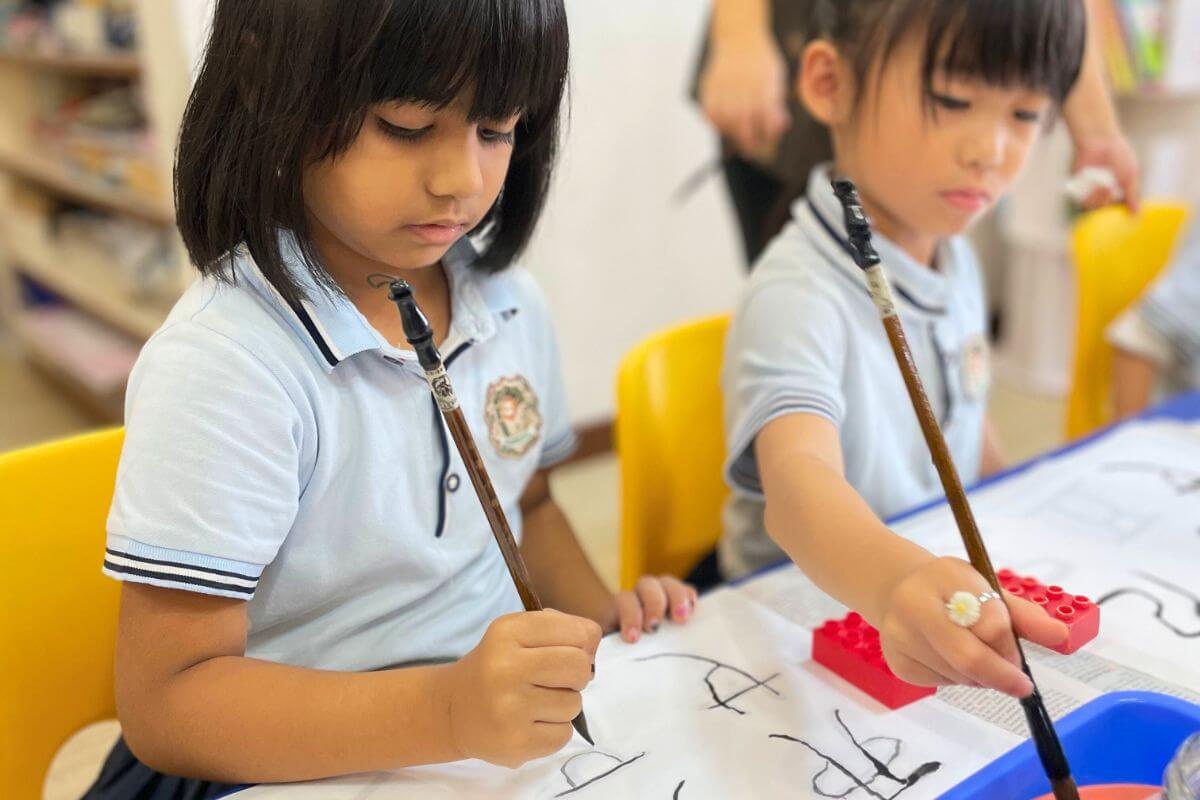Introduction
Montessori education has long been celebrated for its ability to nurture the natural development of children in all aspects—cognitive, social, emotional, and linguistic. Among its many strengths, language and bilingual development stand out as key areas where this child-centered approach truly shines. In today’s interconnected world, bilingualism has become increasingly valuable, and Montessori’s immersive, hands-on approach offers an ideal environment for fostering this skill.
In this article, we will explore how the Montessori method supports language development from infancy through childhood and how its natural and progressive approach creates a supportive space for bilingual learning. Understanding how Montessori education promotes language and bilingualism can help parents, educators, and caregivers make informed decisions when choosing the best learning environment for their children.
For a deeper understanding of how Montessori supports other areas of child development, such as social and emotional growth, you may want to explore this article on social and emotional development.
The Montessori Philosophy and Language Development
Montessori education is rooted in the philosophy of Dr. Maria Montessori, who believed that children learn best through exploration and self-directed activity. This child-led approach is particularly effective in language development, as it encourages natural acquisition rather than forced learning.
Dr. Maria Montessori’s Insights on Language Acquisition
Dr. Montessori observed that language learning is a natural process that unfolds in predictable stages. She noted that children possess an innate ability to absorb language from their environment, especially during the early years of life, which she called the “sensitive period” for language. During this time, children effortlessly acquire language through interaction with their surroundings and people.
Role of the Prepared Environment in Language Learning
In a Montessori classroom, the “prepared environment” is carefully designed to promote exploration and communication. This environment is rich in language materials, from labels and books to storytelling activities, all of which help children expand their vocabulary and linguistic skills.
Emphasis on Child-Centered Learning
One of the core tenets of Montessori is that the learning experience should be child-centered. This means allowing children to learn at their own pace, which fosters a deeper connection to the material. In language development, this individualised approach helps children absorb new words and concepts naturally.
For a broader look at how the Montessori method prepares children for real-world success, check out this comprehensive guide.
Stages of Language Development in Montessori Classrooms
Montessori education acknowledges distinct stages of language development, each supported by specific materials and activities designed to meet the child’s needs.
Pre-Language Stage (Infancy)
From birth to around 12 months, children are absorbing sounds, tones, and rhythms of the language(s) spoken around them. In a Montessori setting, caregivers speak clearly, slowly, and consistently, which provides the child with a strong linguistic foundation.
Spoken Language Stage (Toddler Years)
Between 1 and 3 years old, children begin to experiment with spoken language. Montessori environments support this through naming activities, songs, and interactive dialogue, which help to build their vocabulary and confidence in speaking.
Writing and Reading (Early Childhood)
As children grow, Montessori materials such as sandpaper letters and movable alphabets introduce them to writing and reading. This approach allows children to connect sounds with symbols and encourages literacy development at their own pace.
For more information on how Montessori education fosters cognitive development in early childhood, you can refer to this article on cognitive development.
Hands-On Learning and Language Skills
The Montessori method emphasises hands-on learning, which has a direct impact on language development. When children manipulate Montessori materials, they engage all their senses, which reinforces new vocabulary and concepts.
Role of Sensory Materials in Vocabulary Building
Sensory materials such as the Pink Tower or the Brown Stair introduce descriptive language such as “big,” “small,” “tall,” or “short.” As children manipulate these objects, they absorb new vocabulary related to size, shape, and dimensions.
Practical Life Activities Supporting Language Acquisition
Practical life activities, such as pouring water, dressing frames, and food preparation, introduce a wide range of verbs and action-related words. These activities are also great for fostering conversation, encouraging children to communicate their actions and thoughts.
How Montessori Materials Encourage Verbal Communication
Language is incorporated into nearly every aspect of Montessori learning. Children are encouraged to label their actions, describe their experiences, and engage in discussions, all of which foster verbal communication skills.
For more insights on engaging children in hands-on subjects like science and math, take a look at this resource.
How Montessori Encourages Bilingualism
One of the unique aspects of Montessori education is its support for bilingualism. The flexible, child-centered nature of Montessori environments creates ideal conditions for bilingual language development.
Language Immersion in Montessori Classrooms
In bilingual Montessori classrooms, children are exposed to two or more languages throughout the day. Teachers often switch between languages in natural, conversational contexts, allowing children to hear and use both languages regularly.
Benefits of Bilingualism for Cognitive Development
Research shows that bilingual children often demonstrate greater cognitive flexibility, problem-solving skills, and memory. The Montessori method enhances these benefits by encouraging self-directed, exploratory learning.
Strategies Used in Montessori for Bilingual Language Learning
Montessori classrooms use a range of strategies to support bilingualism, such as storytelling, songs, and language-specific materials. By integrating language into every part of the child’s day, Montessori classrooms foster a natural and immersive bilingual experience.
For parents interested in supporting bilingual learning at home, check out this article on creative ways to make learning Mandarin fun.
The Role of the Montessori Teacher in Language Development
Montessori teachers play a crucial role in supporting language development and bilingualism. They act as guides, providing children with the tools they need to explore language at their own pace.
How Montessori Teachers Support Individualized Language Learning
Teachers observe each child’s development and offer individualised lessons based on their current abilities and interests. This personalised approach ensures that each child’s language journey is unique and tailored to their needs.
Guiding Bilingual and Multilingual Learners in Montessori Settings
In bilingual classrooms, Montessori teachers create an inclusive environment where both languages are given equal importance. They model language use, encourage conversation, and provide cultural context for the languages being taught.
Teacher’s Role in Creating a Language-Rich Environment
Montessori teachers ensure the classroom is a language-rich environment, filled with books, labels, and opportunities for verbal interaction. This stimulates the child’s interest in language and encourages spontaneous communication.
If you’re curious about the importance of positive teacher-child relationships, explore this article.
Language Learning Through Social Interaction and Play
Montessori education strongly supports social interaction as a means of language development. Children are encouraged to collaborate and communicate with their peers, which naturally enhances their language skills.
Peer Learning and Social Engagement in Montessori
Montessori classrooms often include mixed-age groups, allowing younger children to learn from older peers. This creates a rich environment for language development, as children engage in dialogue and observation.
Montessori Play-Based Learning for Language Skills
Play is an integral part of Montessori learning. Children engage in imaginative play and role-playing activities that help them develop conversational skills, storytelling abilities, and social language use.
Encouraging Communication in Group Settings
Group activities, such as circle time and storytelling sessions, provide structured opportunities for children to practice communication. These moments build confidence in speaking and listening in both monolingual and bilingual settings.
For a deeper dive into the role of play in enhancing cognitive development, visit this article.
Supporting Bilingual Families in Montessori Education
Bilingualism is not only fostered in the classroom but also supported by collaboration between teachers and families.
Collaborative Role Between Teachers and Parents
Montessori teachers work closely with parents to ensure language learning continues at home. They offer guidance on how to reinforce both languages in daily activities and provide resources for supporting bilingual development.
Tips for Supporting Bilingualism at Home
Parents can foster bilingualism at home by reading books in both languages, speaking in both languages consistently, and creating opportunities for children to engage with native speakers. Montessori teachers often provide specific strategies to help with this process.
Importance of Home Language Reinforcement
Maintaining the home language is essential for bilingual development. Montessori educators emphasise the importance of parents speaking their native language at home to preserve cultural identity and linguistic balance.
For more advice on supporting language development in children, explore this article on raising confident children.
Benefits of Montessori for Language and Bilingual Development
The Montessori method offers numerous benefits for both language and bilingual development, laying the groundwork for long-term academic and social success.
Enhanced Cognitive Skills through Bilingualism
Children who are exposed to bilingual education in Montessori settings often exhibit greater cognitive flexibility and creativity. Bilingualism enhances brain function by allowing children to switch between languages and process information in unique ways.
Long-Term Academic Advantages
Bilingualism has been shown to improve problem-solving skills, memory, and concentration. Montessori’s approach, with its focus on independence and exploration, helps children build a solid foundation for future academic success.
Case Studies or Examples of Bilingual Success in Montessori
Numerous case studies highlight the success of bilingual students in Montessori settings. These students often excel in both their native and second languages, benefiting from Montessori’s holistic approach to learning.
If you’re interested in how Montessori can shape other aspects of development, consider reading this article on preschoolers’ success.
Challenges and Solutions in Bilingual Montessori Education
While bilingual education in Montessori offers numerous benefits, it also comes with its challenges. However, Montessori has built-in solutions to address these difficulties.
Addressing Common Challenges in Bilingual Language Acquisition
One challenge in bilingual language acquisition is maintaining equal proficiency in both languages. Montessori’s consistent language immersion helps to balance this, ensuring both languages are used regularly in the classroom.
How Montessori Overcomes Obstacles in Multilingual Classrooms
In multilingual classrooms, children may feel overwhelmed by the number of languages spoken. Montessori teachers address this by creating a supportive, non-competitive environment where children are encouraged to express themselves in any language they feel comfortable with.
Conclusion
Montessori education provides a unique and supportive environment for both language development and bilingualism. Through its child-centered approach, prepared environment, and hands-on learning, Montessori fosters natural language acquisition, giving children the tools they need to thrive linguistically.
Bilingualism, in particular, is a skill that Montessori supports through immersive learning, flexible teaching strategies, and a focus on individualized learning. For parents and educators seeking an educational model that values both language and bilingual development, Montessori offers a proven path to success.
For those new to Montessori or looking for guidance on beginning this educational journey, this beginner’s guide offers a great starting point.
Follow us on social media to stay updated on our latest updates and happenings:







Comments are closed